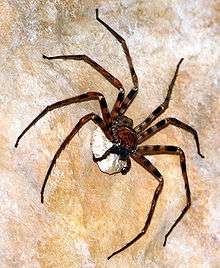Giant huntsman spider
The giant huntsman spider (scientific name Heteropoda maxima), found in Laos, is a species of huntsman spider (Sparassidae), a family of large, fast spiders that actively hunt down prey.[3] It is considered the world's largest spider by leg span,[3] which can reach up to 30 cm (1 ft).[4]
| Giant huntsman spider | |
|---|---|
 | |
| Scientific classification | |
| Kingdom: | Animalia |
| Phylum: | Arthropoda |
| Subphylum: | Chelicerata |
| Class: | Arachnida |
| Order: | Araneae |
| Infraorder: | Araneomorphae |
| Family: | Sparassidae |
| Genus: | Heteropoda |
| Species: | H. maxima |
| Binomial name | |
| Heteropoda maxima | |
Description
The colouration is yellowish-brown with several irregularly distributed dark spots on the rear half. The legs have wide dark bands before the first bend. Like all huntsman spiders, the legs of the giant huntsman spider are long compared to the body, and twist forward in a crab-like fashion.[3]
Apart from its size, the H. maxima can be distinguished from other species of Heteropoda by genital characteristics. On males, the cymbium is at least three times longer than the tegulum. The female is distinguished by a characteristically shaped epigyneal field with two anterior directed bands, and the course of their internal ducts.
The giant huntsman spider is the largest member of the family Sparassidae, boasting a 30 cm (12 in) leg-span, and 4.6 cm (1.8 in) body-length.[2] The largest known member of the Sparassidae known prior to the discovery of H. maxima was the Australian Beregama aurea (L. Koch, 1875) with a body length of about 4 cm (1.6 in).[5] (Other relatively large members of Sparassidae have been discovered in recent years, including Cerbalus aravaensis, the largest in the Middle East).
Taxonomy and naming
Heteropoda maxima was first described in 2001 by P. Jäger,[1] after being discovered in a cave in Laos.[4] Over a thousand new species of plant and animal were found between 1997 and 2007 in the Greater Mekong Subregion.[6]
A representative of the World Wide Fund for Nature stated that "some of these species really have no business being recently discovered",[4] suggesting that it is surprising for such a large species to go undiscovered for so long.
Distribution and habitat
The giant huntsman spider is found in Laos,[3] and is probably a cave dweller because of its pale colour, long legs and special hairs on the second foot of the male. There is no apparent reduction of the eyes, possibly because the species lives near cave entrances.[2][7]
Cannibalism
Florian and Diana Schnös discovered cannibalism within the species of giant huntsman spiders in a cave near Vang Vieng in Laos[3]. Apparently female individuals eat male individuals at times after mating.

See also
- Goliath birdeater (Theraphosa blondi), largest known spider in the world by mass
- Mongolarachne jurassica, the largest known fossilized spider
- Cerbalus aravaensis, a huntsman spider found in Israel and Jordan
References
- "Taxon details Heteropoda maxima Jäger, 2001". World Spider Catalog. Natural History Museum Bern. Retrieved 15 November 2017.
- Jaeger P. 2001. A new species of Heteropoda (Araneae, Sparassidae, Heteropodinae) from Laos, the largest huntsman spider? Zoosystema 23 (3): 461–465.
- Szalay, Jessie (21 November 2013). "Giant Huntsman Spider: World's Largest Spider By Leg Span". Retrieved 20 October 2014.
- "PHOTOS: Cyanide Millipede, Huge Spider Among New Species". National Geographic. Retrieved 17 December 2008.
- "The Find-a-spider Guide: Beregama Aurea". University of South Queensland. Archived from the original on 7 February 2009. Retrieved 18 December 2008.
- "New species discoveries". World Wide Fund for Nature. Archived from the original on 1 February 2009. Retrieved 17 December 2008.
- "New Species Alert!Hot Pink Millipede, Collosal [sic] Spider, and Tiny Deer Emerge". blogs.discovermagazine.com/. Retrieved 18 December 2008.
Further reading
Bayer, Steffen; Jaeger, Peter (June 2009). "Heteropoda species from limestone caves in Laos (Araneae: Sparassidae: Heteropodinae)". Zootaxa. 1 (2143): 23. Retrieved 29 April 2015.
| Wikimedia Commons has media related to Heteropoda maxima. |
| Wikispecies has information related to Heteropoda maxima |